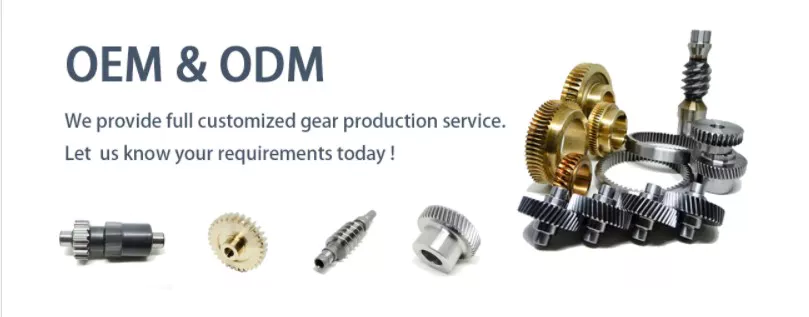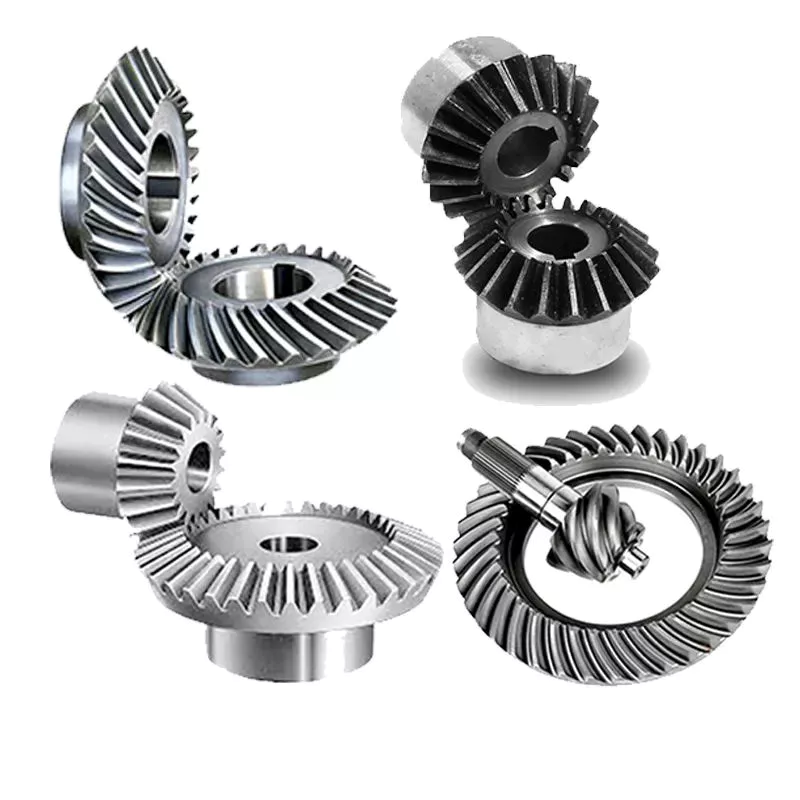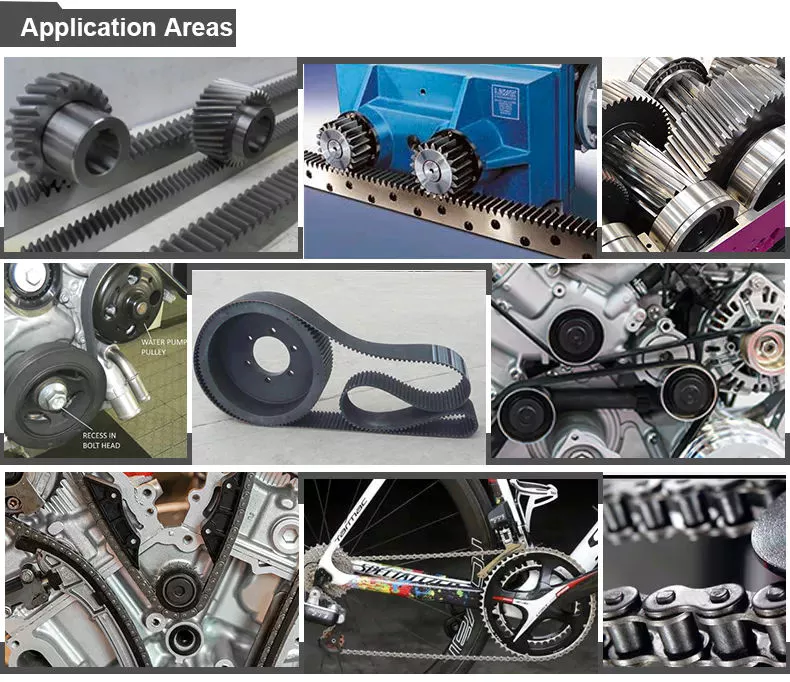Solution Description
How to Style a Forging Spur Gear
Just before you begin developing your personal spur equipment, you need to recognize its principal components. Amongst them are Forging, Keyway, Spline, Set screw and other types. Comprehending the differences amongst these kinds of spur gears is vital for making an educated determination. To find out much more, keep studying. Also, will not hesitate to contact me for help! Outlined under are some beneficial ideas and methods to design and style a spur equipment. Ideally, they will aid you design and style the spur gear of your goals.
Forging spur gears
Forging spur gears is 1 of the most essential procedures of automotive transmission components. The manufacturing approach is intricate and includes a number of measures, this kind of as blank spheroidizing, sizzling forging, annealing, phosphating, and saponification. The content utilised for spur gears is normally 20CrMnTi. The procedure is concluded by applying a steady by means of extrusion forming method with dies made for the sizing band duration L and Splitting angle thickness T.
The method of forging spur gears can also use polyacetal (POM), a robust plastic frequently utilised for the manufacture of gears. This materials is simple to mildew and shape, and right after hardening, it is very rigid and abrasion resistant. A amount of metals and alloys are employed for spur gears, such as forged steel, stainless metal, and aluminum. Detailed below are the diverse kinds of supplies used in gear production and their rewards and drawbacks.
A spur gear’s tooth dimension is calculated in modules, or m. Every single quantity represents the amount of enamel in the equipment. As the amount of tooth increases, so does its size. In standard, the larger the number of enamel, the larger the module is. A high module gear has a large force angle. It is also important to bear in mind that spur gears must have the same module as the gears they are utilised to generate.
Set screw spur gears
A modern sector cannot function with no established screw spur gears. These gears are very efficient and are extensively employed in a assortment of apps. Their design and style entails the calculation of pace and torque, which are equally critical factors. The MEP product, for instance, considers the changing rigidity of a tooth pair along its route. The benefits are utilized to figure out the type of spur gear needed. Detailed underneath are some tips for picking a spur gear:
Variety A. This variety of gear does not have a hub. The gear itself is flat with a modest gap in the middle. Set screw gears are most generally utilized for lightweight purposes without masses. The metal thickness can range from .25 mm to 3 mm. Set screw gears are also utilised for big machines that need to have to be sturdy and tough. This report supplies an introduction to the diverse kinds of spur gears and how they vary from 1 one more.
Pin Hub. Pin hub spur gears use a established screw to safe the pin. These gears are frequently related to a shaft by dowel, spring, or roll pins. The pin is drilled to the specific diameter to fit inside of the gear, so that it does not appear loose. Pin hub spur gears have large tolerances, as the hole is not big adequate to completely grip the shaft. This variety of gear is generally the most high-priced of the a few.
Keyway spur gears
In today’s contemporary market, spur gear transmissions are widely employed to transfer power. These varieties of transmissions provide excellent performance but can be susceptible to power losses. These losses have to be estimated throughout the layout approach. A important element of this investigation is the calculation of the contact area (2b) of the gear pair. However, this worth is not necessarily applicable to each spur gear. Here are some illustrations of how to calculate this region. (See Determine 2)
Spur gears are characterised by having tooth parallel to the shafts and axis, and a pitch line velocity of up to twenty five m/s is considered higher. In addition, they are far more productive than helical gears of the identical dimensions. Not like helical gears, spur gears are typically regarded constructive gears. They are frequently employed for programs in which sound manage is not an problem. The symmetry of the spur equipment helps make them particularly suitable for applications where a consistent speed is needed.
Aside from making use of a helical spur gear for the transmission, the gear can also have a standard tooth condition. In contrast to helical gears, spur gears with an involute tooth type have thick roots, which helps prevent dress in from the teeth. These gears are effortlessly manufactured with standard generation equipment. The involute form is an perfect selection for modest-scale production and is 1 of the most well-liked sorts of spur gears.
Spline spur gears
When contemplating the varieties of spur gears that are utilized, it truly is crucial to observe the variances among the two. A spur gear, also referred to as an involute equipment, generates torque and regulates speed. It is most common in vehicle engines, but is also utilised in each day appliances. However, a single of the most significant disadvantages of spur gears is their sound. Due to the fact spur gears mesh only 1 tooth at a time, they develop a large amount of stress and sounds, producing them unsuitable for daily use.
The get in touch with pressure distribution chart signifies the flank area of every equipment tooth and the distance in equally the axial and profile route. A substantial contact location is positioned towards the center of the equipment, which is caused by the micro-geometry of the equipment. A positive l price indicates that there is no misalignment of the spline enamel on the interface with the helix hand. The opposite is accurate for adverse l values.
Using an higher bound technique, Abdul and Dean analyzed the forging of spur equipment forms. They assumed that the tooth profile would be a straight line. They also examined the non-dimensional forging stress of a spline. Spline spur gears are generally employed in motors, gearboxes, and drills. The toughness of spur gears and splines is mostly dependent on their radii and tooth diameter.
SUS303 and SUS304 stainless steel spur gears
Stainless metal spur gears are created utilizing diverse tactics, which rely on the materials and the software. The most typical method used in production them is reducing. Other procedures include rolling, casting, and forging. In addition, plastic spur gears are developed by injection molding, based on the amount of generation necessary. SUS303 and SUS304 stainless steel spur gears can be manufactured employing a variety of components, such as structural carbon steel S45C, grey cast iron FC200, nonferrous steel C3604, engineering plastic MC901, and stainless metal.
The variances among 304 and 303 stainless steel spur gears lie in their composition. The two sorts of stainless steel share a widespread style, but have various chemical compositions. China and Japan use the letters SUS304 and SUS303, which refer to their different degrees of composition. As with most types of stainless metal, the two distinct grades are made to be utilized in industrial purposes, such as planetary gears and spur gears.
Stainless steel spur gears
There are many items to appear for in a stainless metal spur equipment, including the diametral pitch, the number of enamel for each unit diameter, and the angular velocity of the teeth. All of these aspects are crucial to the functionality of a spur gear, and the appropriate dimensional measurements are important to the layout and operation of a spur gear. Those in the market should be common with the phrases utilized to describe spur equipment components, each to guarantee clarity in creation and in acquire orders.
A spur equipment is a kind of precision cylindrical gear with parallel teeth arranged in a rim. It is employed in different applications, these kinds of as outboard motors, winches, design gear, garden and garden tools, turbine drives, pumps, centrifuges, and a assortment of other equipment. A spur gear is generally made from stainless steel and has a high degree of sturdiness. It is the most generally employed sort of equipment.
Stainless metal spur gears can come in numerous various styles and sizes. Stainless steel spur gears are usually manufactured of SUS304 or SUS303 stainless steel, which are employed for their greater machinability. These gears are then warmth-handled with nitriding or tooth floor induction. Not like standard gears, which need to have tooth grinding after warmth-dealing with, stainless metal spur gears have a minimal put on rate and high machinability.

